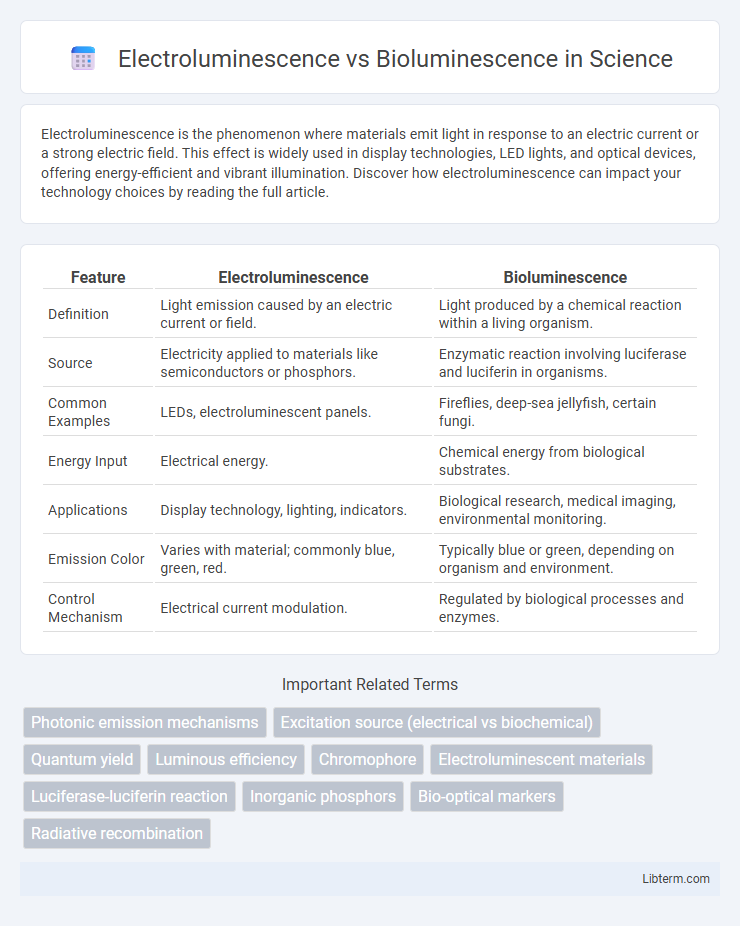Electroluminescence is the phenomenon where materials emit light in response to an electric current or a strong electric field. This effect is widely used in display technologies, LED lights, and optical devices, offering energy-efficient and vibrant illumination. Discover how electroluminescence can impact your technology choices by reading the full article.
Table of Comparison
| Feature | Electroluminescence | Bioluminescence |
|---|---|---|
| Definition | Light emission caused by an electric current or field. | Light produced by a chemical reaction within a living organism. |
| Source | Electricity applied to materials like semiconductors or phosphors. | Enzymatic reaction involving luciferase and luciferin in organisms. |
| Common Examples | LEDs, electroluminescent panels. | Fireflies, deep-sea jellyfish, certain fungi. |
| Energy Input | Electrical energy. | Chemical energy from biological substrates. |
| Applications | Display technology, lighting, indicators. | Biological research, medical imaging, environmental monitoring. |
| Emission Color | Varies with material; commonly blue, green, red. | Typically blue or green, depending on organism and environment. |
| Control Mechanism | Electrical current modulation. | Regulated by biological processes and enzymes. |
Introduction to Electroluminescence and Bioluminescence
Electroluminescence is the phenomenon where materials emit light in response to an electric current or a strong electric field, commonly utilized in LED technology and display panels. Bioluminescence occurs naturally in living organisms such as fireflies, jellyfish, and certain fungi, where biochemical reactions produce visible light without heat. Both processes involve energy conversion into light emission, but electroluminescence relies on electronic excitation, while bioluminescence stems from enzymatic reactions.
Defining Electroluminescence: Principles and Mechanisms
Electroluminescence is the phenomenon where a material emits light in response to an electric current or a strong electric field, primarily observed in semiconductors and phosphors. This process occurs when electrons recombine with holes in the material, releasing energy in the form of photons, which is the fundamental mechanism behind light-emitting diodes (LEDs). Electroluminescence is characterized by direct electrical excitation, distinguishing it from bioluminescence, where light is produced through chemical reactions in living organisms.
Understanding Bioluminescence: Biological Light Production
Bioluminescence is the biological production of light resulting from a chemical reaction involving luciferin, luciferase, oxygen, and ATP within specialized cells of organisms such as fireflies, certain jellyfish, and deep-sea fish. This natural light emission serves various ecological functions including predator avoidance, mating signals, and prey attraction in environments where sunlight is minimal or absent. Unlike electroluminescence, which relies on electrical energy to produce light in semiconductors and devices like LEDs, bioluminescence is an energy-efficient, enzyme-driven biochemical process intrinsic to living organisms.
Key Differences Between Electroluminescence and Bioluminescence
Electroluminescence is the emission of light resulting from an electric current or a strong electric field passing through a material, commonly seen in OLED displays and electroluminescent panels. Bioluminescence involves light production by living organisms through a chemical reaction involving the enzyme luciferase, found in species like fireflies and deep-sea creatures. Key differences include the energy source--electrical excitation for electroluminescence versus biochemical energy for bioluminescence--and the typical contexts, with electroluminescence used in technology and bioluminescence occurring naturally in biological systems.
Real-World Applications of Electroluminescence
Electroluminescence powers energy-efficient LED displays, backlighting for LCD screens, and advanced automotive lighting systems, enabling vibrant, long-lasting illumination with minimal power consumption. Its use in modern wearable technology and flexible electronic devices enhances user experience through bright, customizable visual indicators. This technology revolutionizes urban lighting solutions by providing durable, eco-friendly options for streetlights and signage.
Natural Occurrences and Functions of Bioluminescence
Bioluminescence occurs naturally in marine organisms like jellyfish, fireflies, and certain fungi, serving critical functions such as predator avoidance, mate attraction, and prey luring. Electroluminescence, in contrast, is an artificial phenomenon where materials emit light in response to an electric current, commonly used in display technologies like OLED screens. The natural role of bioluminescence centers on ecological communication and survival mechanisms, highlighting its evolutionary significance in diverse species.
Advantages and Limitations of Electroluminescent Technology
Electroluminescent technology offers advantages such as high energy efficiency, long operational lifespan, and thin, flexible display capabilities ideal for modern electronics and lighting applications. It enables uniform light emission with low heat generation, making it suitable for wearable devices and backlighting in various screens. Limitations include relatively low brightness compared to other light sources and sensitivity to environmental factors like moisture, which can reduce device durability and performance.
Ecological Significance of Bioluminescent Organisms
Bioluminescent organisms play a critical ecological role by facilitating predator-prey interactions, communication, and mating behaviors in marine and terrestrial environments. Their natural light emission helps in camouflage, attracting prey, and deterring predators, maintaining ecological balance. Electroluminescence, contrastingly, serves primarily technological applications, lacking direct environmental or ecological impact.
Innovations Inspired by Electroluminescence and Bioluminescence
Electroluminescence has driven innovations such as flexible OLED displays and energy-efficient lighting panels, revolutionizing consumer electronics and architectural illumination. Bioluminescence inspired advancements in medical imaging and environmental biosensors, enabling real-time monitoring of cellular processes and pollutant detection. Integrating principles from both phenomena, researchers develop biohybrid devices that enhance optical communication and sustainable light emission technologies.
Future Prospects: Bridging Technology and Nature
Electroluminescence harnesses electrical energy to produce light with applications in advanced display technologies and energy-efficient lighting, while bioluminescence leverages natural enzymatic reactions for sustainable, low-energy illumination in biological and environmental monitoring. Future prospects emphasize integrating bioluminescent mechanisms into electroluminescent devices to create hybrid systems that offer enhanced efficiency, adaptability, and environmentally-friendly alternatives. Innovations in genetic engineering and material science aim to bridge the gap between technology and nature, enabling self-powered, biodegradable light sources revolutionizing medical diagnostics, wearable tech, and ecological sensing.
Electroluminescence Infographic

 libterm.com
libterm.com